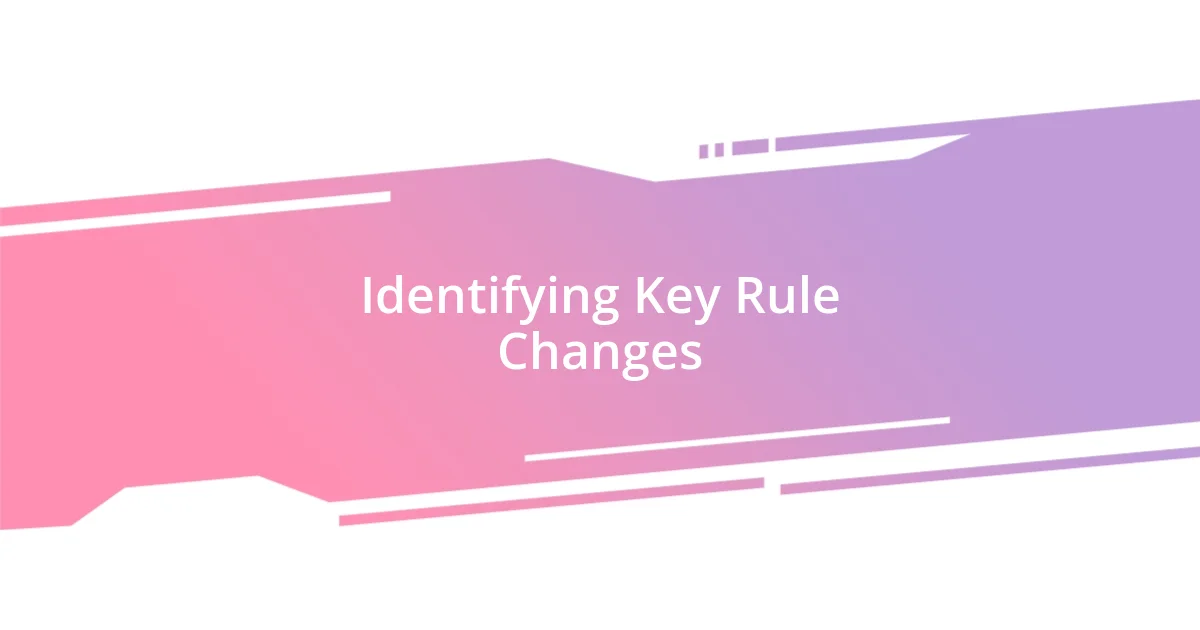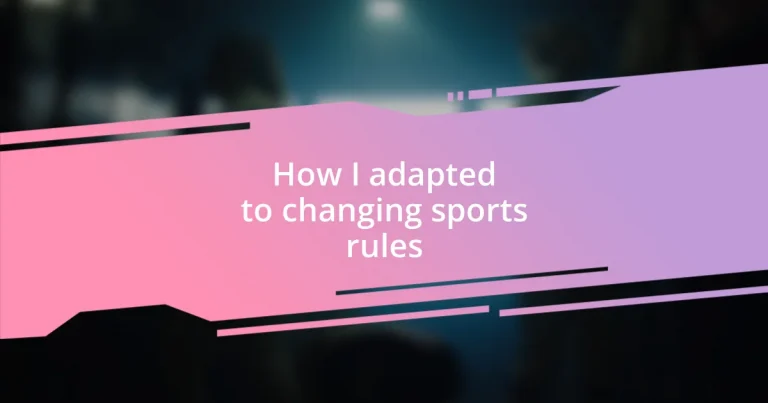Key takeaways:
- Adapting to changing sports rules fosters growth, resilience, and improved performance through strategic adjustments and embracing new opportunities.
- Continuous learning and feedback, including staying informed about rule changes and collaborating with teammates, enhances skills and confidence in adapting strategies.
- A positive mindset and support from teammates play crucial roles in navigating challenges, turning frustrations into growth experiences and fostering a resilient sports culture.

Understanding the Importance of Adaptation
Adapting to changing sports rules isn’t just beneficial; it’s essential for growth. I remember when new time regulations were introduced in basketball. At first, I felt overwhelmed, like I was trying to keep up with a moving train. But that challenge pushed me to re-evaluate my strategies and ultimately improved my gameplay. Isn’t it fascinating how pressure can lead to greater resilience?
Consider the emotional rollercoaster that comes with adaptation. I experienced this firsthand with the introduction of video assistance in officiating. Initially, I felt frustrated watching the game slow down for reviews, but I soon recognized that this innovation aimed to enhance fairness. This shift prompted me to become more aware of the game dynamics, and I realized that embracing change can spark long-term benefits.
Every time I face a new rule change, I ask myself: How can I turn this into an opportunity? I recalled a tournament where a new substitution rule was implemented. Instead of resisting it, I embraced the chance to learn from my teammates’ approaches, which not only enriched my understanding of the sport but also strengthened our team bond. In those moments of uncertainty, I discovered that flexibility is my secret weapon for success.

Identifying Key Rule Changes
Identifying key rule changes is crucial for any athlete looking to excel. I often find myself scanning official announcements, eager to understand the latest updates. For instance, during a recent soccer season, a sudden change in the offside rule left many players confused. Initially, I felt a mix of anxiety and curiosity, prompting me to research the implications and adapt my playing style accordingly. Understanding these shifts not only keeps my skills sharp but also enhances my overall enjoyment of the game.
When I look back at my experience, some key rule changes that stood out to me were:
- Introduction of a shot clock in basketball, which sped up the game.
- Allowing video assistant referees (VAR) in soccer to support officiating.
- Alterations to the three-point line distance that impacted shooting strategies.
- Changes to contact rules in football, promoting player safety.
- Adjustments in tennis serving rules, affecting strategy on serve-and-volley plays.
These changes pushed me to think critically about my game and how I could integrate new strategies into my play. Every adjustment felt like a chance to expand my horizons; embracing them helped transform initial frustrations into growth.

Assessing the Impact on Performance
The impact of changing sports rules on performance can be profound. I recall a time when a new rule mandated a longer recovery period between bursts of effort in rugby. Personally, I thought it would hinder our momentum, but instead, I learned to optimize my energy. This allowed me to maintain focus during intense moments. Adapting to such changes can enhance overall game performance.
In my experience, the adjustments often require recalibrating not only physical strategies but mental approaches as well. I remember when my football league introduced stricter offside regulations, making previously acceptable plays obsolete. At first, I struggled to read the game effectively, feeling the pressure to adapt quickly. However, this forced me to sharpen my decision-making skills, leading to more strategic play and a deeper understanding of positioning.
Understanding this relationship between the rules and performance ultimately helps us grow as athletes. It encourages reflection and sparks curiosity about how we can improve continuously. I’ve learned to view these changes not just as hurdles but as opportunities for innovation and growth. Each adaptation shapes my journey and enhances my competitive edge.
| Rule Change | Impact on Performance |
|---|---|
| Longer recovery period in rugby | Improved energy management and focus |
| Stricter offside regulations in football | Enhanced decision-making and strategic awareness |

Developing a Responsive Training Plan
Developing a responsive training plan has been crucial in navigating the changes in sports rules. When the shot clock was introduced in basketball, I felt both excitement and pressure. I quickly realized that my training sessions needed to prioritize speed and decision-making under time constraints. I worked with my coach to simulate game scenarios, where I’d only have 14 seconds to shoot. This adaptiveness not only improved my performance but also reignited my passion for the game.
I’ve also faced challenges when adjusting my training methods to accommodate changes in rules. After the implementation of VAR in soccer, I found myself second-guessing my moves on the field, worried that any slight misstep would be scrutinized. At that moment, I incorporated video analysis into my training, reviewing my plays to gain confidence in my decisions. It taught me that sometimes, embracing technology helps in creating a more informed and responsive training approach.
Furthermore, emotional readiness became part of my strategy. I recall when football introduced new contact rules aimed at player safety. Initially, the thought of restricting tackles made me anxious. However, I chose to turn that anxiety into focus by adjusting my drills. I practiced timed reactions and footwork to overcome the urge to tackle too aggressively. This shift not only built my confidence but also made me a more strategic player, allowing me to thrive under the new regulations. Isn’t it fascinating how changing rules can lead to self-discovery and growth?

Incorporating Feedback and Analysis
Incorporating feedback effectively is a cornerstone of adapting to changing sports rules. I vividly remember a time when my basketball team altered our defensive approach due to a new three-point line placement. Initially, I felt overwhelmed and uncertain about my defensive role. However, gathering feedback from my coach and teammates helped me identify areas for improvement, which boosted my confidence and allowed me to adjust my strategy on the court. Have you ever felt that moment when collaborative insights transformed a challenge into an opportunity?
Analysis also plays a vital role in this adaptation process. After a diving header rule adjustment in soccer, I found myself questioning my aerial duels. Instead of shying away from challenges, I began filming my training sessions to study my technique. By analyzing my positioning and timing against different opponents, I discovered not just where I faltered but also how I could elevate my game. This kind of self-assessment sparks growth, wouldn’t you agree?
Finally, integrating constant feedback loops becomes essential to thrive under new regulations. I often seek out input not just from my coaches but from fellow athletes who share similar experiences. For instance, when a new tackling rule was introduced in rugby, I began discussing strategies with teammates after each game. Those conversations uncovered insights I hadn’t considered before. They challenged me to think critically and adapt my playing style continuously. Isn’t it amazing how collaboration and analysis can cultivate a mindset primed for improvement?

Staying Informed About Future Changes
Staying updated on rule changes requires a proactive approach. I make it a habit to follow official sports associations and leagues on social media. Recently, when my sport introduced new guidelines on equipment safety, the timely updates I found online helped me prepare mentally and physically ahead of the season. Isn’t it reassuring to have a direct line to the information that impacts your game?
I also attend workshops and seminars whenever possible. Just last year, I participated in a coaching clinic that focused on changes to training regimens due to evolving rule structures. Listening to industry experts not only clarified my understanding but also ignited a fresh spark of enthusiasm in me. It’s fascinating how these experiences create a sense of community among athletes and coaches alike, don’t you think?
Sometimes, I even turn to podcasts and online forums to hear different perspectives. During a road trip for an away game, I listened to a podcast featuring sports analysts discussing potential future changes. That conversation helped me see the rules from multiple angles, opening my mind to new strategies I might not have considered. How do you stay informed? I believe that diversifying my sources keeps me engaged and ready to embrace change as it comes.

Embracing a Positive Mindset
Embracing a positive mindset is crucial when navigating the often turbulent waters of changing sports rules. I remember the first time a major rule tweak was announced in my league. At first, I could feel the tension creeping in, but then I shifted my perspective—what if this change opened up new opportunities for growth? That little mental shift transformed my apprehension into excitement, enabling me to view the upcoming season as a chance to innovate my game rather than simply a set of obstacles to overcome.
Having a positive mindset doesn’t mean burying your head in the sand about challenges. It’s about acknowledging them while still believing in your ability to overcome. During a particularly tough training session where we were adapting to a stricter officiating style, my frustration was palpable. Yet, I reminded myself that these moments are often the precursor to breakthrough performances. That realization pushed me to dig deeper and refine my skills further, ultimately resulting in a more effective and confident playing style. Have you ever turned a moment of frustration into one of growth?
In my experience, surrounding yourself with positive influences is equally important. I’ve found that training with teammates who maintain an uplifting attitude about adaptations can change the atmosphere and foster resilience. There were days when I felt like giving up, especially after a loss due to a new rule that caught us off guard. However, my teammates rallied, focusing on what we could learn rather than what we did wrong. Their optimism was contagious, and it helped me remember that adapting to change is as much about the journey as it is about the outcome. Isn’t it inspiring how a shared outlook can lift the entire team?














